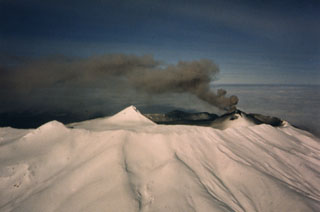Report on Akutan (United States) — April 1992
Bulletin of the Global Volcanism Network, vol. 17, no. 4 (April 1992)
Managing Editor: Lindsay McClelland.
Akutan (United States) Small ash plumes
Please cite this report as:
Global Volcanism Program, 1992. Report on Akutan (United States) (McClelland, L., ed.). Bulletin of the Global Volcanism Network, 17:4. Smithsonian Institution. https://doi.org/10.5479/si.GVP.BGVN199204-311320
Akutan
United States
54.134°N, 165.986°W; summit elev. 1303 m
All times are local (unless otherwise noted)
Minor ash emission . . . continued through late April. Residents of Akutan village (16 km NE of the volcano) suggested that ash emission may have occurred on 20 or 21 April. A dark streak that was presumed to be ash was visible on the E flank when weather cleared 22 April. A videotape taken by Reeve Aleutian Airways personnel on 26 April showed vigorous steaming from the prominent cinder cone in the summit crater, and fresh ash on the snowfields S of the cone. That day, a pilot saw ash rising to ~2.5 km altitude (roughly 1.2 km above the summit), but no ashfall was reported from Akutan village. Activity was next seen on 21 May, when Mark Owen (Trident Seafoods, Akutan village) observed fresh ash on the snow-covered flank during the early morning, and brief emissions of dark ash that rose an estimated 250-300 m above the volcano at about 1000 and 1400.
Geological Summary. Akutan contains a 2-km-wide caldera with a large cinder cone in the NE part of the caldera that has been the source of frequent explosive eruptions and occasional lava effusion that covers the caldera floor. An older, largely buried caldera was formed during the late Pleistocene or early Holocene. Two volcanic centers are located on the NW flank. Lava Peak is of Pleistocene age, and a cinder cone lower on the flank produced a lava flow in 1852 that extended the shoreline of the island and forms Lava Point. The 60-365 m deep younger caldera was formed during a major explosive eruption about 1,600 years ago and contains at least three lakes. A lava flow in 1978 traveled through a narrow breach in the north caldera rim almost to the coast. Fumaroles occur at the base of the caldera cinder cone, and hot springs are located NE of the caldera at the head of Hot Springs Bay valley and along the shores of Hot Springs Bay.
Information Contacts: AVO.

